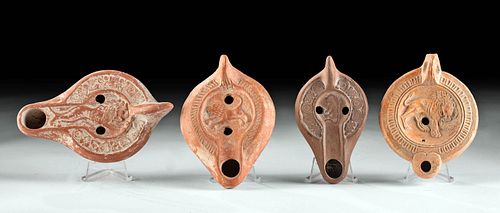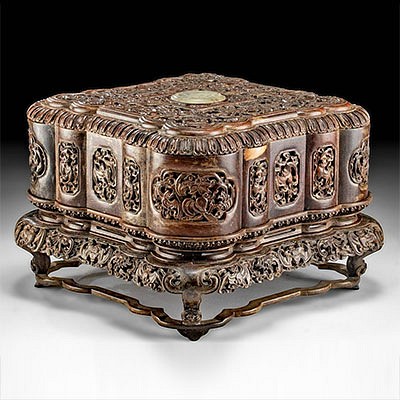Four Roman North African Terracotta Oil Lamp with Lions
Lot 16c
About Seller
Artemis Fine Arts
686 S Taylor Ave, Ste 106
Louisville, CO 80027
United States
Selling antiquities, ancient and ethnographic art online since 1993, Artemis Gallery specializes in Classical Antiquities (Egyptian, Greek, Roman, Near Eastern), Asian, Pre-Columbian, African / Tribal / Oceanographic art. Our extensive inventory includes pottery, stone, metal, wood, glass and textil...Read more
Categories
Estimate:
$2,000 - $3,000
Absentee vs Live bid
Two ways to bid:
- Leave a max absentee bid and the platform will bid on your behalf up to your maximum bid during the live auction.
- Bid live during the auction and your bids will be submitted real-time to the auctioneer.
Bid Increments
| Price | Bid Increment |
|---|---|
| $0 | $25 |
| $300 | $50 |
| $1,000 | $100 |
| $2,000 | $250 |
| $5,000 | $500 |
| $10,000 | $1,000 |
| $20,000 | $2,500 |
| $50,000 | $5,000 |
| $100,000 | $10,000 |
| $200,000 | $20,000 |
About Auction
By Artemis Fine Arts
Apr 8, 2021
Set Reminder
2021-04-08 10:00:00
2021-04-08 10:00:00
America/New_York
Bidsquare
Bidsquare : Fine Antiquities | Asian | Ethnographic Art
https://www.bidsquare.com/auctions/artemis-gallery/fine-antiquities-asian-ethnographic-art-6770
Features classical antiquities, ancient and ethnographic art from cultures encompassing the globe. Egyptian, Greek, Roman, Etruscan, Near Eastern, Asian, Pre-Columbian, Native American, African / Tribal, Oceanic, Spanish Colonial, Russian, Fine Art, so much more! All legally acquired, legal to sell. Artemis Fine Arts info@artemisfinearts.com
Features classical antiquities, ancient and ethnographic art from cultures encompassing the globe. Egyptian, Greek, Roman, Etruscan, Near Eastern, Asian, Pre-Columbian, Native American, African / Tribal, Oceanic, Spanish Colonial, Russian, Fine Art, so much more! All legally acquired, legal to sell. Artemis Fine Arts info@artemisfinearts.com
- Lot Description
Rome, North African, ca. 4th to 5th century CE. An exemplary ensemble of four mold-made pottery oil lamps adorned with tondos of lions delineated in relief - each presenting a wick spout, a risen handle, a circular base, and two fill holes. Boasting a light shade of orange, the first ancient vessel displays a discoid form with a rounded spout, a loop handle, and a recessed central tondo of a striding lion with a thick mane surrounded by a tabbed border. The next lamp also showcases a sunken central tondo containing a lion, depicted while seated and open-mouthed in a fierce roar. Enveloped in a deep hue of chocolate brown, this vessel features a pointed handle, an intricate border of abstract motifs, and a recessed canal that connects the spout and tondo. Third, the salmon pink oil lamp exhibits a pinched handle, an incised border of parallel striations, a leaping lion, and an indecipherable maker's mark on its base. Size of largest: 5.5" L x 3.125" W x 1.875" H (14 cm x 7.9 cm x 4.8 cm)
Most intricately decorated of the four, the last example shows the profile of a lion with his muscular hind legs stretched down the lengthy neck of the lamp, so his feet rest at the spout, while his hefty head and forelegs push up against the handle. A circular border of alternating square and V-shaped motifs adorns the periphery of the tondo.
In the classical world, lions symbolized power, wealth, and might. They were famously featured in many ancient myths, perhaps the most famous being that of Hercules (Greek Herakles) slaying the Nemean lion for his first labor. The lions fur was believed to be impenetrable to attacks since according to legend it was made of gold and its claws were far sharper than swords with the power to slice through armor. In the end, Hercules defeated the lion by strangling it and wore its skin.
Lions were also favorite iconography for buildings, coins, and statues. Examples include the Lion Gate to the Citadel of Mycenae, the Terrace of the Lions on the island of Delos, and the lion hunt mosaic from Pella featuring Alexander engaged in a lion hunt. Of course lions were also used in the Roman arenas where they would fight other animals, such as tigers and bears.
Please note that the Lucite stands are for photography purposes only.
Provenance: private Florida collection, USA; ex-private Boca Raton collection, Florida, USA, before 2000
All items legal to buy/sell under U.S. Statute covering cultural patrimony Code 2600, CHAPTER 14, and are guaranteed to be as described or your money back.
A Certificate of Authenticity will accompany all winning bids.
We ship worldwide and handle all shipping in-house for your convenience.
#162857Discoid lamp has had restoration to handle and other three have repair to handles with restoration over break lines. Expected surface wear with light nicks and abrasions throughout. Otherwise, all are excellent with lovely earthen deposits throughout.Condition
- Shipping Info
-
All shipping is handled in-house for your convenience. Your invoice from Artemis Gallery will include shipping calculation instructions. If in doubt, please inquire BEFORE bidding for estimated shipping costs for individual items.
-
- Buyer's Premium



 EUR
EUR CAD
CAD AUD
AUD GBP
GBP MXN
MXN HKD
HKD CNY
CNY MYR
MYR SEK
SEK SGD
SGD CHF
CHF THB
THB














